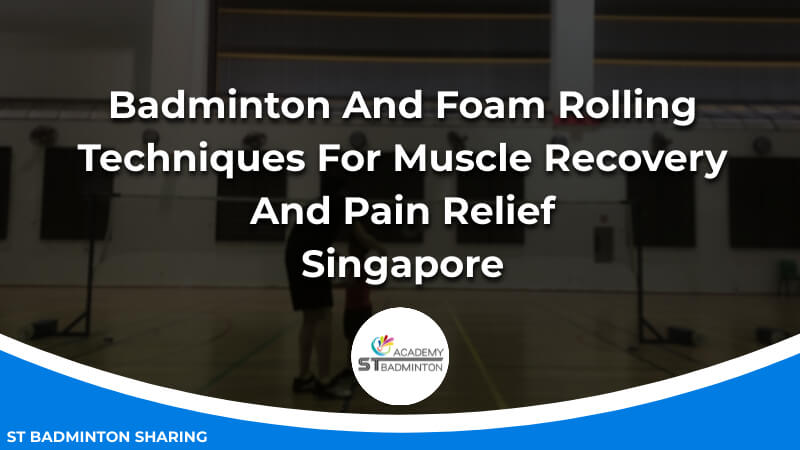Welcome to ST Badminton Academy’s badminton training in Malaysia! I’m a badminton and foam rolling expert, here to tell you about two amazing techniques for muscle recovery and pain relief. Whether you’re an avid badminton player or just starting out, these techniques are simple but incredibly effective. And don’t worry if you have never tried foam rolling before – I’ll show you the basics so that anyone can benefit from it in no time at all.
Let me start by telling you why muscle recovery is so important after a game of badminton. As with any other sport, when playing badminton your muscles will become tense and tight due to physical exertion, which can lead to soreness and injury if not dealt with properly.
This is where my expertise comes in: both foam rolling and specific exercises designed for badminton players can help reduce tension, improve mobility, relieve pain, and ultimately result in faster recovery times – allowing you to get back on the court as soon as possible!
So let’s dive into how these two methods work together to bring about optimal results.
Benefits Of Foam Rolling After Badminton Training
Foam rolling is like a massage for your muscles; it’s an essential tool in the arsenal of any athlete looking to stay injury-free and feel their best. Like a blanket of relief, foam rolling can soothe away soreness while providing countless stretching benefits. With just a few minutes each day, you can unlock powerful muscle activation that will help you move better, perform at higher levels, and recover faster—allowing you to put in more reps on the court or field with confidence.
Other than choosing a good racket and also remember to choose the best racket restring in Malaysia. Badminton players benefit from exercises specifically designed for their sport. Not only do these drills strengthen key areas such as arms and legs, but they also improve balance, coordination, and reaction time – all necessary traits for success in badminton.
By taking into account unique movements associated with playing badminton, athletes can build strength and power without sacrificing agility or speed. Developing an effective exercise program tailored to individual needs can take performance to the next level by improving specific skills that are advantageous during game play.
Rolling out tight muscles before activity prepares them for movement and prevents overstretching which could lead to future pain or injuries — allowing athletes to remain active longer than ever before!
Benefits Of Exercises For Badminton Players
If you’re a serious badminton player, exercises are a great way to boost your agility and joint mobility.
Foam rolling is an effective technique for muscle recovery and pain relief, and can help you stay at the top of your game.
Enhanced Agility
Playing badminton regularly can help you to become more agile and improve your overall performance. Improved agility means better balance, quick reactions, and improved strength which are all beneficial for any badminton player.
Through a combination of foam rolling exercises and specific drills designed to target core muscles such as the glutes, hamstrings, and quads, players can significantly increase their speed while also improving their ability to change directions quickly – essential skills on the court!
My clients have seen amazing results in terms of increased mobility, flexibility, endurance, and skill level by incorporating these techniques into their pre-game warmups.
The end result? A smoother transition from defense to offense with less chance for missteps or fatigue – resulting in an even more successful game for you!
Improved Joint Mobility
In addition to improving agility and overall performance, regular foam rolling and stretching routines can also help badminton players improve their joint mobility.
Stretching helps the muscles stay loose and relaxed so they are more responsive to quick movements.
Core strengthening exercises such as planks or bridges help keep your joints stable during rapid changes in direction on the court, reducing the risk of injury.
As a coach, I have seen my clients become much better at controlling their bodies when executing shots after implementing these specific drills into their training regimen.
It’s amazing how dramatically improved coordination and balance can lead to increased confidence!
All it takes is some dedication and consistency with a good exercise routine – trust me, you’ll be glad you did!
What To Foam Roll
When it comes to foam rolling, there are a few things you should know.
The first thing is that pre-rolling is an important component of your muscle recovery and pain relief routine. Pre-rolling helps lubricate the muscles before stretching or training which can help reduce any risk of injury while also helping to improve performance.
Secondly, post-stretching is another important part of your foam rolling regimen as this will help keep the muscles from becoming stiff after intense activity.
And lastly, learning how to properly foam roll ensures that you get the maximum benefit out of each session by targeting the right areas with the correct amount of pressure for optimal results. To ensure that you’re getting the most out of your foam rolling sessions, here’s a four-point checklist:
| Maximizing Foam Rolling Sessions: Four-Point Checklist | Description |
|---|---|
| Allocate Adequate Time: | – Ensure sufficient time for both pre-rolling and post-stretching exercises during each foam rolling session. |
| Apply Appropriate Pressure: | – Use suitable amounts of pressure when foam rolling specific areas of your body. Adjust the pressure based on your comfort level for optimal results. |
| Focus on Breathing: | – Concentrate on controlled breathing throughout the entire foam rolling process to maximize relaxation and enhance the effectiveness of the session. |
| Take Breaks Between Sets: | – Incorporate breaks between foam rolling sets as needed to prevent overworking your muscles. This helps maintain a balanced and safe approach to your foam rolling routine. |
Now that we’ve gone through what needs to be done before and after our foam rolling session, let’s take a look at how exactly one should go about performing these techniques correctly.
How To Foam Roll
Foam rolling is a great way to relax tight muscles and enhance recovery after a badminton session. It’s like getting an extra massage, but without the price tag! While it may seem intimidating at first, foam rolling can be a simple and effective technique for reducing muscle tension and improving flexibility. Plus, you don’t need special equipment – just your own body weight!
Now that we’ve talked about what to foam roll let’s discuss how to do it properly.
Start by finding any areas of tension in your body. Stretching drills can help identify these areas so you know where to focus on when using a foam roller.
Once you find the source of the discomfort or pain, move slowly over the area with light pressure until you feel relief. You might want to use short rolling strokes or longer ones depending on your comfort level; both are perfectly fine as long as they make you feel better!
Finally, keep breathing steadily throughout each foam rolling exercise and listen to your body – if something doesn’t feel right then stop immediately.
With consistent practice, you’ll soon become an expert in relieving muscle tension through foam rolling!
Exercises For Badminton Players
As a badminton and foam rolling expert, I know that stretching techniques and plyometric drills are important elements of any player’s routine. Properly performing these exercises can help to relieve tension in the muscles, reduce recovery time between games, and prevent injury.
Stretching is an essential part of a warm-up before playing badminton. Stretches should be done both pre-game and post-game, as they will get your body ready for the game while also helping you cool down afterward.
Plyometrics drills involve explosive movements such as jumping or hopping on one foot; they are great for increasing power output during a match. These exercises not only improve muscle coordination but also increase cardio fitness levels. So make sure to add them to your training regime!
With regular practice and dedication, you’ll soon see results – improved performance on the court, faster reflexes, and better balance – all thanks to stretching and plyometric drills!
Frequently Asked Questions

How Long Should I Foam Roll For Muscle Recovery And Pain Relief?
If you’re looking for an answer to how long should I foam roll for muscle recovery and pain relief, the simple answer is: there’s no one-size-fits-all solution.
With a little bit of elbow grease and dedication, though, you can achieve maximum results in no time!
Foam rolling has become an incredibly popular technique among badminton players who are serious about their performance—especially when it comes to avoiding muscle fatigue or soreness.
Not only does it provide instant relief from discomfort, but regular stretching tips can help prevent future issues as well.
Whether you’re looking for immediate gratification or long-term success, foam rolling is sure to be your secret weapon like nothing else!
Is Foam Rolling Beneficial For All Types Of Athletes?
Foam rolling is great for athletes of all skill levels. It’s an effective stretching technique that can help relieve muscle fatigue, while also providing a nice massage to reduce pain and tension.
I recommend foam rolling after a badminton match or practice session, as it can be particularly beneficial in aiding recovery and reducing soreness.
Research has shown that those who regularly use foam rollers experience improved athletic performance due to increased range of motion and improved flexibility.
So if you’re looking for an easy way to improve your badminton game, why not give foam rolling a try? You’ll be surprised by the results!
Are There Any Contraindications To Foam Rolling?
As a badminton and foam rolling expert, I’m often asked if there are any contraindications to foam rolling.
While it can be an effective stretching technique as part of a dynamic warm-up, there may be some cases where you should avoid foam rolling altogether.
For example, if you have recently suffered from joint or muscle trauma, such as sprains, strains, or fractures – which is common in athletes – then it’s best to seek medical advice before using the foam roller for muscle recovery and pain relief.
In these cases, consulting with your physician to tailor specific exercises that won’t aggravate your injury is recommended.
How Often Should I Do Exercises For Badminton Players?
When it comes to improving your performance as a badminton player, stretching techniques and correct posture are essential.
It’s important to do exercises regularly in order to keep up with the demands of this sport.
I’d recommend that you do some form of exercise at least two or three times per week, depending on how often you play badminton.
Stretching not only helps increase flexibility but also improves joint mobility.
Additionally, foam rolling can help release tight muscles while promoting muscle recovery after each game.
Doing these exercises consistently will go a long way toward helping you stay healthy and perform better during matches!
Do I Need Special Equipment To Do Exercises For Badminton Players?
If you’re a badminton player looking to take your training and recovery routine up a notch, you may be wondering whether or not you need special equipment for exercises.
The answer is no – all you really need is some stretching techniques and court training!
Sure, foam rolling can come in handy from time to time if you want to focus on muscle recovery and pain relief, but it’s definitely not essential.
I recommend incorporating various stretches into your warm-up before each session so that your body can stay flexible and resilient over the course of the game.
That way, even when fatigue starts setting in, you’ll still have enough energy left over to give it you’re all till the end!
Foam Rolling Expert After Badminton Training
As an experienced badminton player and foam rolling expert, I can confidently say that incorporating both techniques into your daily routine will help you to optimize muscle recovery and reduce pain.
Badminton is a high-impact sport that requires consistent stretching, strength training, and conditioning exercises in order to prevent injury.
Foam rolling provides additional support by releasing tension from tight muscles; it also reduces inflammation and increases circulation throughout the body.
If used correctly, these two incredible techniques will work together harmoniously to ensure you perform at your peak when playing badminton.
It’s like putting on a protective force field of comfort around your body – allowing you to move freely with minimal risk of pain or strain!
So make sure you take the time to invest in yourself, as your physical health should always be a top priority for any serious athlete.





